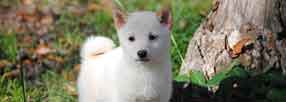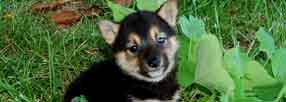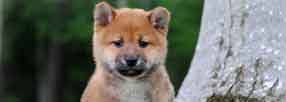|
|
What are Roundworms in Dogs and PuppiesIntroduction
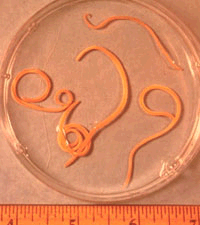 Adult Roundworms How Infection OccursIn dogs, there are four ways by which infection with Toxocara canis occurs:
Life as a RoundwormToxocara canis has one of the most amazing life cycles in the animal kingdom. It is crucial to understand this life cycle if effective treatment is to be pursued. 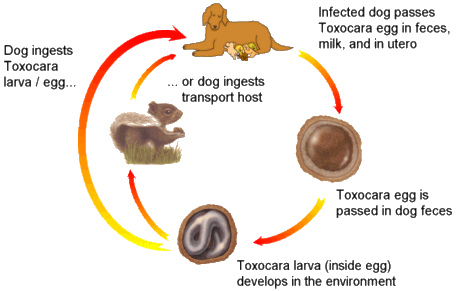 Adult Roundworms Step One: Toxocara eggs are passed in the host's feces. If a fecal sample is tested, the eggs can be detected. The embryonic worm develops in the outdoor environment inside its microscopic egg for one month before it becomes able to infect a new host. If environmental conditions are favorable, it takes about a month for the egg to become infective but Toxocara eggs are famous for weathering harsh environmental conditions. Eggs can remain infective for months to years. Note: Fresh feces are not infectious. Soil contaminated with feces is infectious. Step Two: The egg containing what is called a second stage larva is picked up from the dirt by a dog or by some other animal, usually in the course of normal grooming. The egg hatches in the new host's intestinal tract and the young worm burrows its way out of the intestinal tract to encyst in the host's other body tissues. If the new host is a dog, the life cycle proceeds. If the new host is a member of another species, the larvae wait encysted until the new host is eaten by a dog. Step Three: These second stage larvae can remain encysted happily for years. If the host is a dog, the larvae mostly encyst in the host's liver. When the time comes to move on, the larvae excyst and migrate to the host's lungs where they develop into third stage larvae. They burrow into the small airways and travel upward towards the host's throat. A heavy infection can produce a serious pneumonia. When they get to the upper airways, their presence generates coughing. The worms are coughed up into the host's throat where they are swallowed, thus entering the intestinal tract for the second time in their development. If the host is pregnant, the larvae do not migrate to the lung after they excyst; instead they home to the uterus and infect the unborn puppies. The second stage larvae make their way to the puppies' lungs to develop into third stage larvae. If the host is a nursing mother, second stage larvae can migrate to the mammary gland instead of the lung after excysting. Puppies can be infected by drinking their mother's milk, although due to the intrauterine cycle described above, the litter would probably already be infected. Note: When dogs are dewormed with traditional dewormers, this affects only worms in the intestinal tract. It does not affect encysted larvae. It is difficult to prevent mother to puppy transmission and routine deworming is not adequate. It is possible to prevent infection in unborn puppies by using a specific daily protocol of fenbendazole or with the new generation products containing moxidectin (your veterinarian can provide details). Step Four: Once back in the intestine, the larvae complete their maturation and begin to mate. The first eggs are laid about one week after the fourth stage larvae have arrived in the intestine and about 4 to 5 weeks after infection has first occurred. From here the cycle repeats. Why is infection Bad?Roundworm infection can have numerous negative effects. It is a common cause of diarrhea in young animals and can cause vomiting as well. Sometimes the worms themselves are vomited up, which can be alarming as they can be quite large with females reaching lengths of up to seven inches. The worms consume the host's food and can lead to unthriftiness and a classical pot-bellied appearance. Heavy infections can lead to pneumonia as the worms migrate, and if there are enough worms the intestine can become obstructed. It should also be noted that human infection by this parasite is especially serious (see below). It is important to minimize the contamination of environmental soil with the feces of infected animals so as to reduce the exposure hazard to both humans and other animals. How do we Know if our Dog is Infected?You may not know if your dog is infected, and this is one of the arguments in favor of regular deworming. Regular deworming is especially recommended for dogs that hunt and might consume the flesh of hosts carrying worm larvae. Puppies are frequently simply assumed to be infected and automatically dewormed. Of course, there are ways to find out if your dog is infected. If a dog or puppy vomits up a worm, there is a good chance this is a roundworm (especially in a puppy). Roundworms are long, white and described as looking like spaghetti. Tapeworms can also be vomited up but these are flat and obviously segmented. If you are not sure what type of worm you are seeing, bring it to your veterinarian's office for identification. Fecal testing for worm eggs is a must for puppies and a good idea for adult dogs having their annual check up. Obviously, if there are worms, they must be laying eggs in order to be detected, but by and large fecal testing is a reliable method of detection. Roundworms (Toxocara canis) are common intestinal nematode parasites of dogs. The parasite is extremely common in puppies; however, a strong immunity begins to develop in most dogs by 2-3 months of age. Consequently, in well-cared-for pet dogs that have been dewormed as young puppies, infection is uncommon. But young dogs with suppressed immunity due to malnourishment or some other concurrent disease (such as is common in stray dogs) are likely to be infected. Roundworms have a complex life cycle; following infection, larval worms undergo an extensive migration through the liver and lungs before migrating back to the intestine where they complete their development and begin to shed eggs into the feces. How do we get rid of Roundworms?Numerous deworming products are effective. Some are over the counter and some are prescription. Many flea control and/or heartworm prevention products provide a monthly deworming that is especially helpful in minimizing environmental contamination. Common active ingredients include:
There are two important concepts to keep in mind about deworming. Medications essentially anesthetize the worm so that it lets go of its grip on the host's intestine and passes out with the stool. Once it has been passed, it cannot survive in the environment and dies. This means that you will likely see the worms when they pass, so be prepared as they can be quite long and may still be alive and moving when you see them. Because of the importance of roundworms to the health of both dogs and humans, veterinarians recommend that all puppies be treated at regular intervals and that all adult dogs be tested and treated as needed. The American Association of Veterinary Parasitologists, together with the Centers for Disease Control and Prevention, have issued recommendations to treat all puppies at 2, 4, 6, 8, and 12 weeks. It is also recommended to then place all dogs on a monthly heartworm preventative that also kills roundworms. Worms are killed rapidly following treatment with appropriate drugs, and treated dogs will cease shedding eggs within 2 days following treatment. Therefore, proper veterinary care of newborn puppies and immediate veterinary examination and treatment of all newly acquired pet dogs (whether strays or from another source), together with regular feces pickup, can virtually eliminate the risk for transmission to children in the home. Outside of the home (such as playgrounds), it is important that leash and clean-up laws are observed diligently. The other concept stems from the fact that all the larvae in migration cannot be killed by any of these products. After the worms are cleared from the intestine, they will be replaced by new worms completing their migration. This means that a second and sometimes even a third deworming is needed to keep the intestine clear. The follow-up deworming is generally given several weeks following the first deworming to allow for migrating worms to arrive in the intestine where they are vulnerable. Do not forget your follow-up deworming. What about Toxascaris Leonina?The life cycle of Toxascaris leonina is not nearly as complicated. They do not migrate through the body in the way that Toxocara does. Instead, the Toxascaris second stage larva is consumed and simply matures in the intestine, a process that takes 2 to 3 months. Like Toxocara, Toxascaris can infect hosts of other species, though with Toxascaris the larvae can develop into third stage larvae in these other hosts while with Toxocara larval development is arrested in species other than the dog. 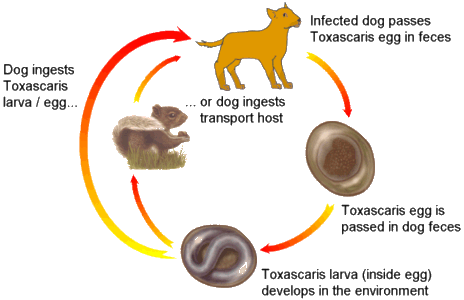 Toxascaris leonina can infect dogs |
|
|
|
© 2010-2016 Shiba-Inu-Breeders.com • All Rights Reserved • www.Shiba-Inu-Breeders.com Fair Use Notice: This site may contain copyrighted material whose use has not been specifically authorized by the copyright owners. We believe that this not-for-profit, educational use on the Web constitutes a fair use of the copyrighted material (as provided for in section 107 of the US Copyright Law). If you wish to use this copyrighted material for purposes of your own that go beyond fair use, you must obtain permission from the copyright owner. |













